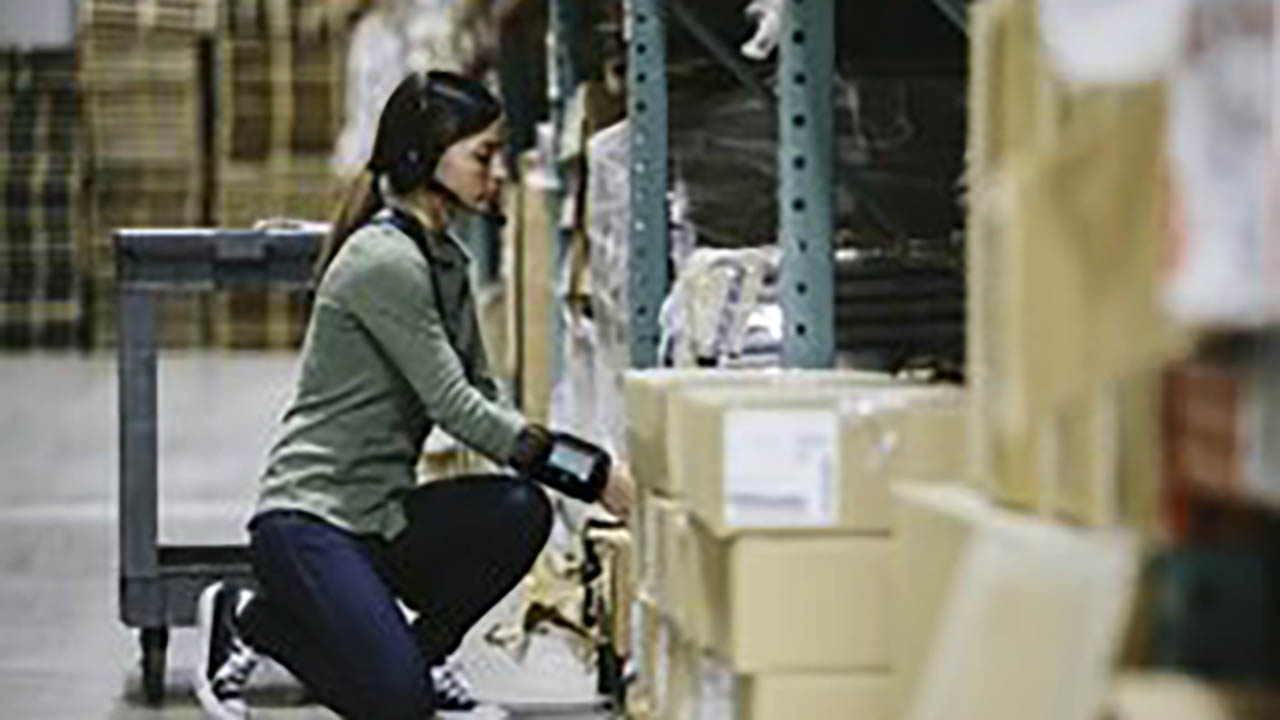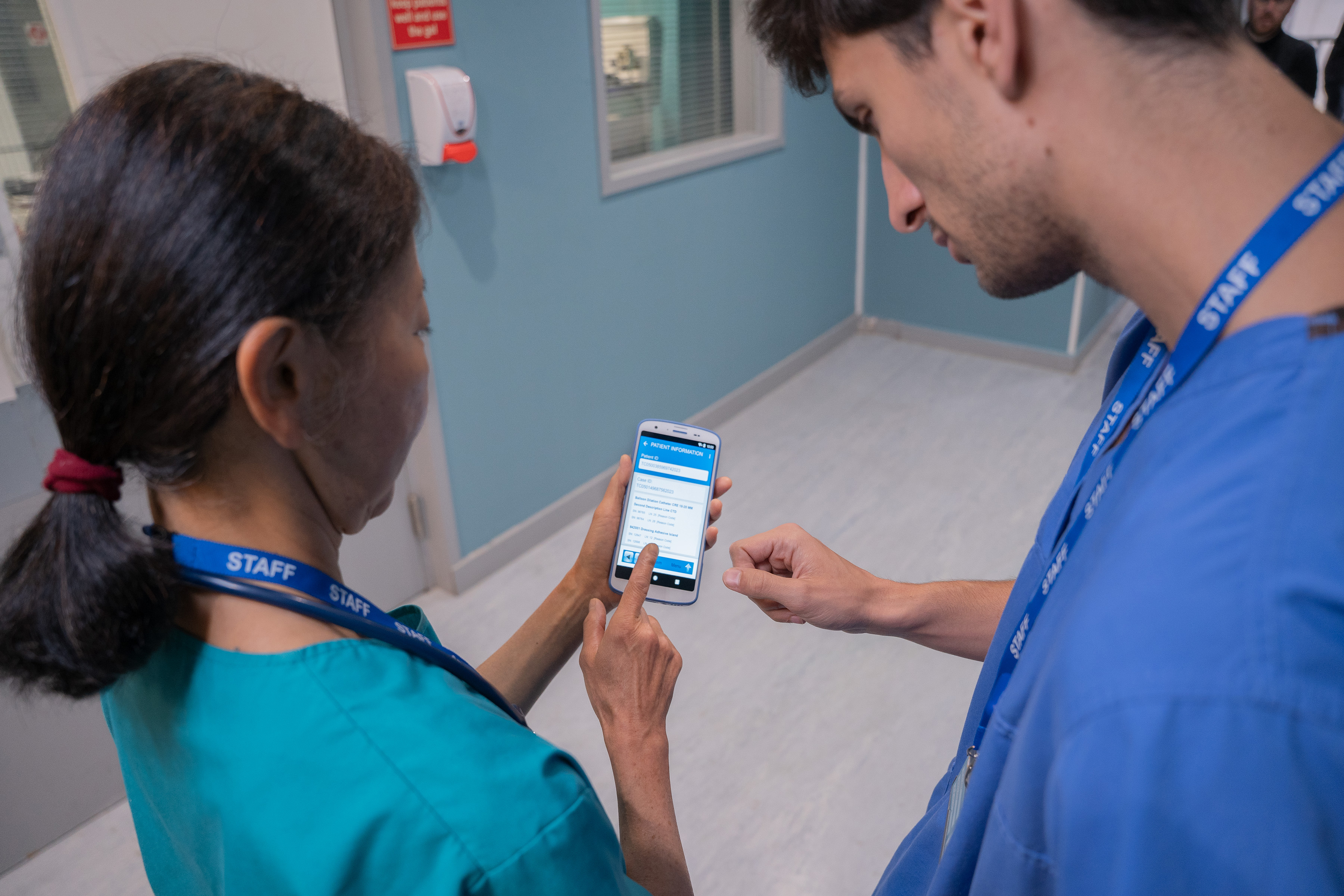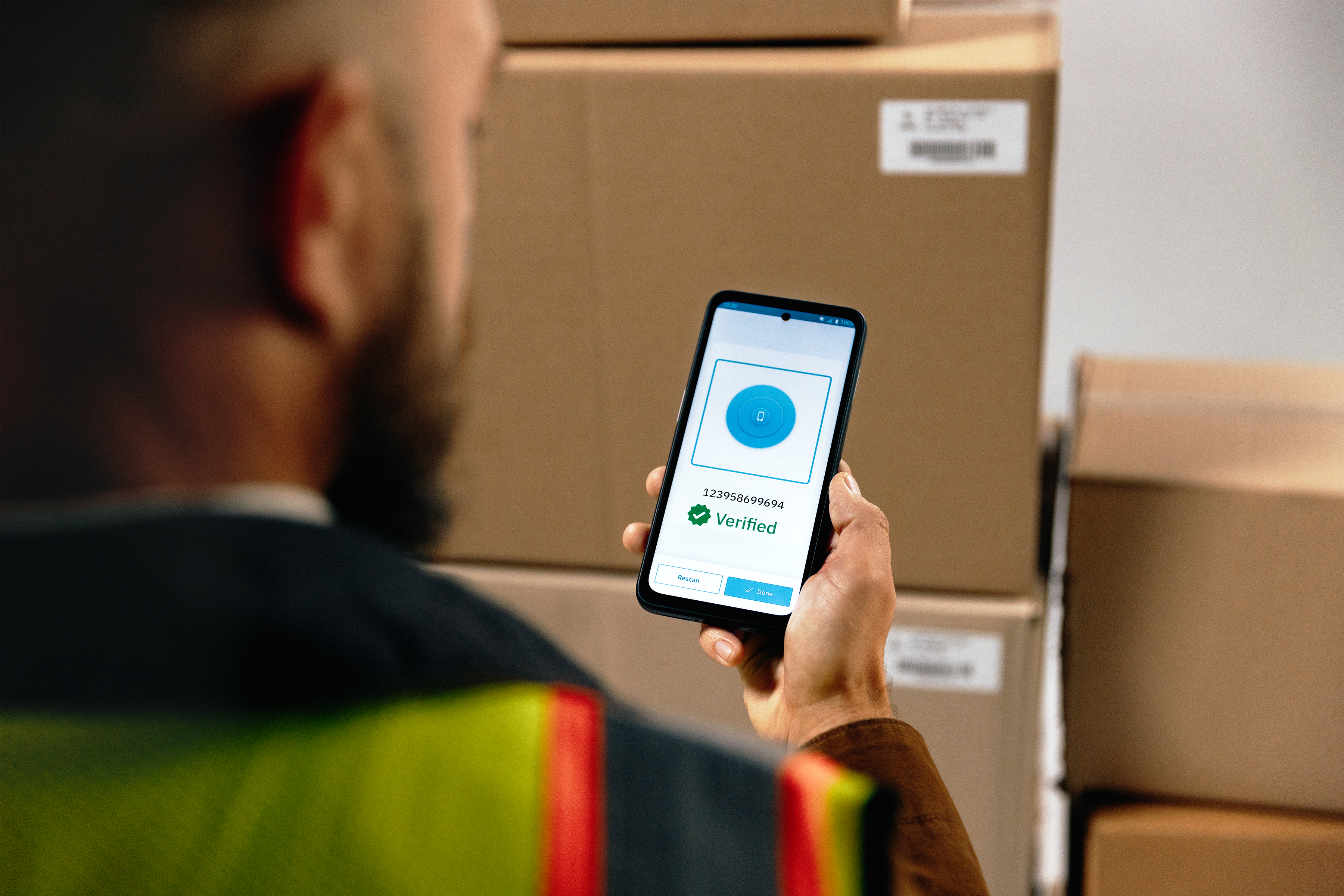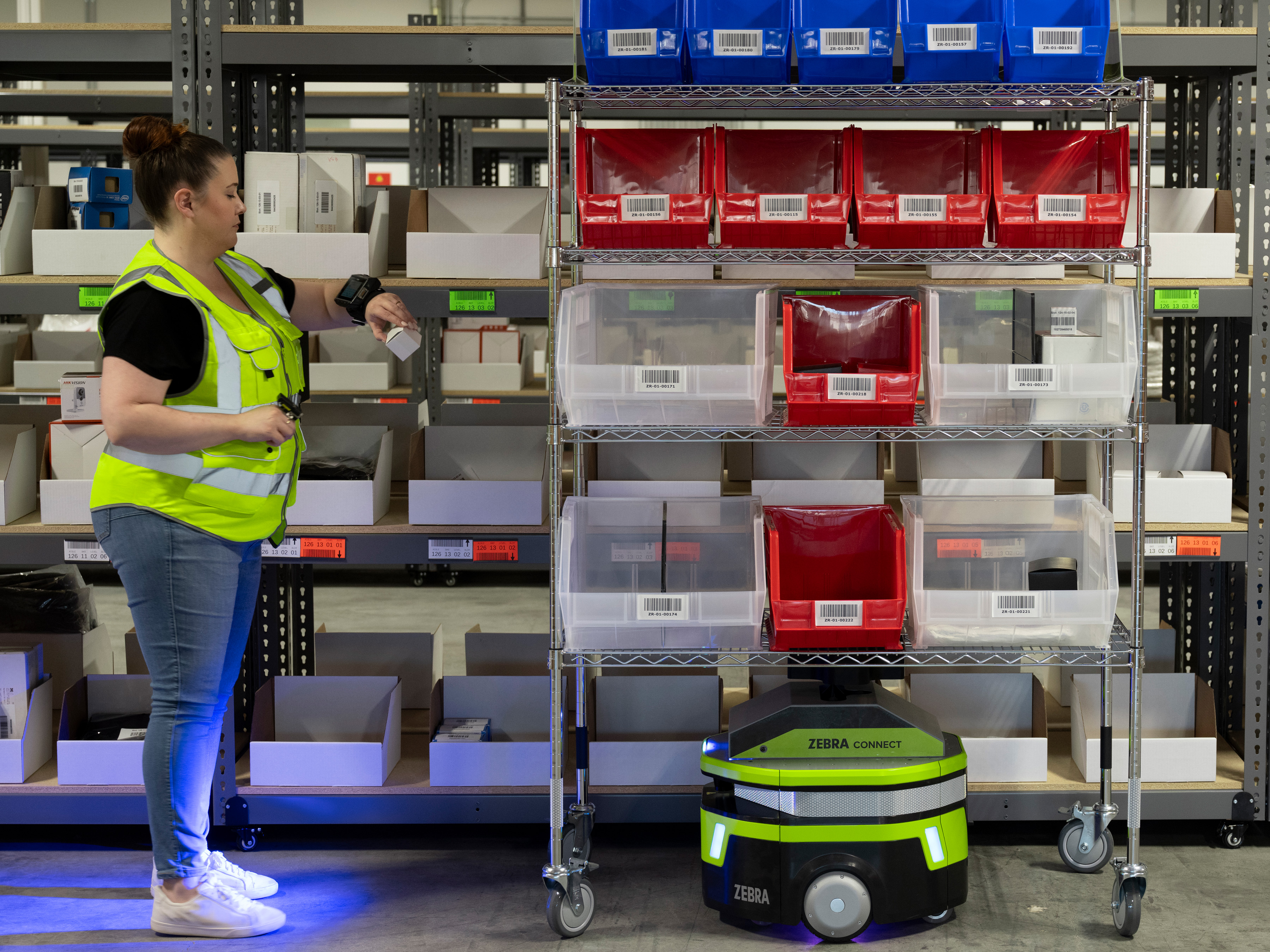Transform retail operations with Zebra’s retail technology solutions, featuring hardware and software for improving inventory management and empowering teams.
Streamline operations with Zebra’s healthcare technology solutions, featuring hardware and software to improve staff collaboration and optimize workflows.
Enhance processes with Zebra’s manufacturing technology solutions, featuring hardware and software for automation, data analysis, and factory connectivity.
Zebra’s transportation and logistics technology solutions feature hardware and software for enhancing route planning, visibility, and automating processes.
Learn how Zebra's public sector technology solutions empower state and local governments to improve efficiency with asset tracking and data capture devices.
Zebra's hospitality technology solutions equip your hotel and restaurant staff to deliver superior customer and guest service through inventory tracking and more.
Zebra's market-leading solutions and products improve customer satisfaction with a lower cost per interaction by keeping service representatives connected with colleagues, customers, management and the tools they use to satisfy customers across the supply chain.
Empower your field workers with purpose-driven mobile technology solutions to help them capture and share critical data in any environment.
Zebra's range of Banking technology solutions enables banks to minimize costs and to increase revenue throughout their branch network. Learn more.
Zebra's range of mobile computers equip your workforce with the devices they need from handhelds and tablets to wearables and vehicle-mounted computers.
Zebra's desktop, mobile, industrial, and portable printers for barcode labels, receipts, RFID tags and cards give you smarter ways to track and manage assets.
Zebra's 1D and 2D corded and cordless barcode scanners anticipate any scanning challenge in a variety of environments, whether retail, healthcare, T&L or manufacturing.
Zebra's extensive range of RAIN RFID readers, antennas, and printers give you consistent and accurate tracking.
Choose Zebra's reliable barcode, RFID and card supplies carefully selected to ensure high performance, print quality, durability and readability.
Zebra's location technologies provide real-time tracking for your organization to better manage and optimize your critical assets and create more efficient workflows.
Zebra's rugged tablets and 2-in-1 laptops are thin and lightweight, yet rugged to work wherever you do on familiar and easy-to-use Windows or Android OS.
With Zebra's family of fixed industrial scanners and machine vision technologies, you can tailor your solutions to your environment and applications.
Zebra’s line of kiosks can meet any self-service or digital signage need, from checking prices and stock on an in-aisle store kiosk to fully-featured kiosks that can be deployed on the wall, counter, desktop or floor in a retail store, hotel, airport check-in gate, physician’s office, local government office and more.
Adapt to market shifts, enhance worker productivity and secure long-term growth with AMRs. Deploy, redeploy and optimize autonomous mobile robots with ease.
Discover Zebra’s range of accessories from chargers, communication cables to cases to help you customize your mobile device for optimal efficiency.
Zebra's environmental sensors monitor temperature-sensitive products, offering data insights on environmental conditions across industry applications.
Enhance frontline operations with Zebra’s AI software solutions, which optimize workflows, streamline processes, and simplify tasks for improved business outcomes.
Zebra Workcloud, enterprise software solutions boost efficiency, cut costs, improve inventory management, simplify communication and optimize resources.
Keep labor costs low, your talent happy and your organization compliant. Create an agile operation that can navigate unexpected schedule changes and customer demand to drive sales, satisfy customers and improve your bottom line.
Drive successful enterprise collaboration with prioritized task notifications and improved communication capabilities for easier team collaboration.
Get full visibility of your inventory and automatically pinpoint leaks across all channels.
Reduce uncertainty when you anticipate market volatility. Predict, plan and stay agile to align inventory with shifting demand.
Drive down costs while driving up employee, security, and network performance with software designed to enhance Zebra's wireless infrastructure and mobile solutions.
Explore Zebra’s printer software to integrate, manage and monitor printers easily, maximizing IT resources and minimizing down time.
Make the most of every stage of your scanning journey from deployment to optimization. Zebra's barcode scanner software lets you keep devices current and adapt them to your business needs for a stronger ROI across the full lifecycle.
RFID development, demonstration and production software and utilities help you build and manage your RFID deployments more efficiently.
RFID development, demonstration and production software and utilities help you build and manage your RFID deployments more efficiently.
Zebra DNA is the industry’s broadest suite of enterprise software that delivers an ideal experience for all during the entire lifetime of every Zebra device.
Advance your digital transformation and execute your strategic plans with the help of the right location and tracking technology.
Boost warehouse and manufacturing operations with Symmetry, an AMR software for fleet management of Autonomous Mobile Robots and streamlined automation workflows.
The Zebra Aurora suite of machine vision software enables users to solve their track-and-trace, vision inspection and industrial automation needs.
Zebra Aurora Focus brings a new level of simplicity to controlling enterprise-wide manufacturing and logistics automation solutions. With this powerful interface, it’s easy to set up, deploy and run Zebra’s Fixed Industrial Scanners and Machine Vision Smart Cameras, eliminating the need for different tools and reducing training and deployment time.
Aurora Imaging Library™, formerly Matrox Imaging Library, machine-vision software development kit (SDK) has a deep collection of tools for image capture, processing, analysis, annotation, display, and archiving. Code-level customization starts here.
Aurora Design Assistant™, formerly Matrox Design Assistant, integrated development environment (IDE) is a flowchart-based platform for building machine vision applications, with templates to speed up development and bring solutions online quicker.
Designed for experienced programmers proficient in vision applications, Aurora Vision Library provides the same sophisticated functionality as our Aurora Vision Studio software but presented in programming language.
Aurora Vision Studio, an image processing software for machine & computer vision engineers, allows quick creation, integration & monitoring of powerful OEM vision applications.
Adding innovative tech is critical to your success, but it can be complex and disruptive. Professional Services help you accelerate adoption, and maximize productivity without affecting your workflows, business processes and finances.
Zebra's Managed Service delivers worry-free device management to ensure ultimate uptime for your Zebra Mobile Computers and Printers via dedicated experts.
Find ways you can contact Zebra Technologies’ Support, including Email and Chat, ask a technical question or initiate a Repair Request.
Zebra's Circular Economy Program helps you manage today’s challenges and plan for tomorrow with smart solutions that are good for your budget and the environment.
The Zebra Knowledge Center provides learning expertise that can be tailored to meet the specific needs of your environment.
Zebra has a wide variety of courses to train you and your staff, ranging from scheduled sessions to remote offerings as well as custom tailored to your specific needs.
Build your reputation with Zebra's certification offerings. Zebra offers a variety of options that can help you progress your career path forward.
Build your reputation with Zebra's certification offerings. Zebra offers a variety of options that can help you progress your career path forward.

How to Boost Supply Chain Resilience Through Digital Transformation
This post was written by Jessie Stoks, Sr. Product Marketing Manager at VMware, a Zebra Independent Software Vendor (ISV).
It’s been over a year since the COVID-19 pandemic completely disrupted the global supply chain, and only a few months since I wondered if I’d ever see a fully-stocked aisle of paper products again. The pandemic made it abundantly clear how globally interconnected and complex supply and demand has become, and this historic shock exposed vulnerabilities across the entire manufacturing process—posing significant challenges to those across the supply chain ecosystem. Businesses spanning all sectors were forced to rapidly address existing problems and redefine their supply chain strategies to become more connected and resilient, with many increasing investments in digital transformation and the front-line worker experience (EX).
This trend isn’t completely surprising, though.
In a shifting market with constant disruption, digital technologies remain the biggest accelerator for growth, efficiency, and innovation. For example, the retail sector, which saw exponential growth in online spending and e-commerce in 2020, has aggressively accelerated adoption of digital tools and omnichannel capabilities to enable new ways of working and offer more customer-centric services, like in-store or curbside pickup and home delivery. And during the first three industrial revolutions, spanning from the turn of the century to the early 2000s, the supply chain was at the forefront of technological innovation.
While logistics and distribution have been quick to digitize in more recent years, other supply chain sectors, like manufacturing, have been slow to adopt digital transformation initiatives. In 2020, this changed dramatically, with warehousing and manufacturing organizations eager to redefine operating models and make the shift to digital.
The Growing Dependency on Digital Technologies
Digital transformation enables businesses to improve their supply chain operations of today and build long-term resiliency for tomorrow by expanding their ability to quickly adapt and recover from disruption. However, this journey requires organizations to reevaluate their current supply chain strategies, establish new long-term digital strategies, and begin implementing new technologies and processes.
According to the 2021 MHI Annual Industry Report, 85% of supply chain leaders expect digital to be the predominant supply chain model over the next five years, with 49% already accelerating their spend on digital technologies. MHI reported a notable increase in investments across cloud computing, inventory optimization, sensors, robotics automation, and predictive analytics. Mobile and wearable technologies also saw a substantial increase in terms of supply chain investments.
While advanced Industry 4.0 technologies like blockchain, artificial intelligence (AI), drones, machine learning, and Industrial Internet of Things (IIoT) are still evolving and several years away for many organizations, mobile computers, barcode scanners, and wearable devices remain an easy and cost-effective way for supply chains to quickly accelerate digitization efforts. Unlike paper-based systems and fixed computer terminals, mobile and wearable technologies give multiple supply chain stakeholders real-time visibility into their inventory, assets, and people as they make it easy to efficiently and accurately capture and share data. In fact, Gartner predicts that “up to 70% of new mobile investments over the next five years will be for front-line workers.”
Leading supply chain organizations are also combining traditional and cutting-edge technologies to create seamless omnichannel experiences across their ecosystem. For example, mobile devices with push-to-talk capabilities facilitate fast voice communication and collaboration among team members. And heads-up displays that provide real-time guidance via augmented reality (AR) applications are being used to improve manufacturing processes across the plant floor, warehouse, and field by delivering hands-free instructions, visual diagrams, and reference materials directly to the workers’ line-of-sight. Organizations are also leveraging AR and virtual reality (VR) technologies to provide new or less-experienced workers with easy access to remote experts and immersive, hands-on training. Since mobile devices used by front-line workers also have a direct impact on EX, increased adoption of devices like rugged handheld computers, barcode scanners, and mobile printers will also help supply chains be more competitive in attracting and retaining top talent.
Boost EX by Prioritizing the Needs of Front-line Workers
In addition to implementing the right digital technologies, supply chains must also put their workforce at the heart of digitization efforts. Overnight, supply chain workers became the unsung heroes of 2020. As shutdowns and shortages disrupted the global supply chain, front-line workers continued to manufacture, move, and stock the personal protective equipment (PPE), food and other essential items communities needed. As we begin to move forward, front-line workers will be the key to success when it comes to mobilization efforts and supply chain resilience.
That’s why it’s important for organizations to retrain and reskill existing workers to align with transformation efforts. Workers must feel comfortable embracing new digital tools and processes. Employee disengagement is the number one cause of turnover, and the biggest culprit of employee disengagement is (insufficient) technology. With front-line workers in record demand, and many supply chain sectors experiencing 50-100% annual turnover (the average sits at 19%), it is critical for supply chains to create a modern, tech-enabled work environment that attracts and retains skilled workers.
.A unified endpoint management (UEM) solution can help supply chain workers adopt new ways of working by providing a consumer-like digital experience. For example, you can choose to only give shift-based workers access to the apps and content they need to stay focused. And you can proactively manage endpoints with device and app analytics to mitigate downtime. Integrated remote worker support is also critical to quickly assist workers with device tasks and issues when inevitable problems arise. Many supply chains have also started implementing “bring your own device” (BYOD) policies to ensure critical information can be delivered to workers’ personal devices onsite, in the field, and at home.
However, mobilizing a distributed front-line workforce spanning a diverse ecosystem, across geographies and use cases, can be challenging. Furthermore, increased connectivity and reliance on third-party partners, subcontractors, and suppliers adds to this complexity and can create security and compliance vulnerabilities. While cloud computing and a flexible IT infrastructure allows supply chains to scale to support changing market demands, a unified digital-first management platform enables IT to reduce operational complexity, maximize worker EX, protect assets, and streamline compliance.
How to Maximize Digital Investments and Front-line Worker EX with UEM
A UEM strategy empowers IT to consolidate existing management silos, reduce costs, and improve security across digital technologies deployed throughout the supply chain. But it is important supply chain leaders choose a UEM solution that supports any endpoint, platform, and use case. It should also integrate access control, app management, analytics, and intrinsic security into a single platform. It’s also critical that the solution is scalable so IT can support an evolving mobile landscape and remain agile, regardless of deployment size or scope.
Most importantly, a UEM tool must include features and capabilities that are purpose-built to support mission-critical devices used by front-line workers across the supply chain, including:
- low-touch enrollment and configuration to support devices deployed in remote environments with limited connectivity or bandwidth.
- shared device management, so IT can customize the device user interface (UI), lock into single or multi-app mode, and enable check-in/check-out for shift-based workers.
- enterprise-grade device security tools and the ability to silently install content and operating system (OS) updates to ensure devices are always protected and up to date.
- device and app analytics and automation to proactively monitor and remediate issues using historical data.
- real-time remote view and control capabilities to assist workers with device tasks and issues, whether in the field or onsite.
The Takeaway
Supply chain organizations need end-to-end digital strategies that account for every use case, need, and vulnerability across the entire ecosystem—from planning and procurement to manufacturing and logistics. Deploying mobile devices that boost worker productivity and efficiency will be fundamental, as will adopting IoT technologies that drive automation. Supply chain organizations must also consider the investments needed in people, not just technology, to make operations more connected, employee-centric, and resilient. No matter which digital technology platforms are ultimately deployed, know the key to a successful digital supply chain is the integration of a UEM solution that streamlines management and security, simplifies IT complexity, and empowers front-line workers.
Editor’s Note:
As a trusted Zebra partner, VMware has maintained a rapid pace of innovation to help customers across the supply chain maintain business continuity and become more resilient with Workspace ONE Unified Endpoint Management (UEM). Workspace ONE was specifically built to address the unique management requirements of mission-critical devices. Workspace ONE enables organizations to quickly and easily stage, manage and support Zebra deployments—alongside existing mobile and laptop deployments—with low-touch enrollment and configuration, shared device management, device and app analytics, remote worker support, and more. To learn more, visit www.vmware.com/solutions/empower-frontline-workers.html.
Source: Gartner, Hype Cycle for Frontline Worker Technologies, 2020, Leif-Olof Wallin and Rob Smith, July 7, 2020
Zebra Developer Blog
Zebra Developer Blog
Are you a Zebra Developer? Find more technical discussions on our Developer Portal blog.
Zebra Story Hub
Zebra Story Hub
Looking for more expert insights? Visit the Zebra Story Hub for more interviews, news, and industry trend analysis.
Search the Blog
Search the Blog
Use the below link to search all of our blog posts.
Most Recent
Legal Terms of Use Privacy Policy Supply Chain Transparency
ZEBRA and the stylized Zebra head are trademarks of Zebra Technologies Corp., registered in many jurisdictions worldwide. All other trademarks are the property of their respective owners. ©2025 Zebra Technologies Corp. and/or its affiliates.






